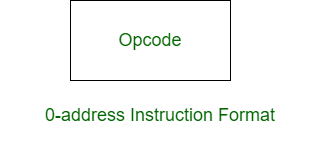先决条件 – 指令格式
1. 三地址指令:
三地址指令是机器指令的一种格式。它有一个操作码和三个地址字段。一个地址字段用于目的地,两个地址字段用于源。

例子:
X = (A + B) x (C + D) 解决方案:
ADD R1, A, B R1 <- M[A] + M[B]
ADD R2, C, D R2 <- M[C] + M[D]
MUL X, R1, R2 M[X] <- R1 x R2 2. 零地址指令:
零地址指令是机器指令的一种格式。它只有一个操作码,没有地址字段。

例子:
X = (A + B) x (C + D) 解决方案:
LOAD A AC <- M[A]
PUSH A TOS <- A
PUSH B TOS <- B
ADD TOS <- (A + B)
PUSH C TOS <- C
PUSH D TOS <- D
ADD TOS <- (C + D)
MUL TOS <- (C + D) x (A + B)
POP X M[X] <- TOS 三地址指令和零地址指令的区别:
| THREE-ADDRESS INSTRUCTION | ZERO-ADDRESS INSTRUCTION |
|---|---|
| It has four fields. | It has only one field. |
| It has one field for opcode and three fields for address. | It has one field for opcode and no fields for address. |
| It has long instruction length. | It has shorter instruction. |
| It is slower accessing location inside processor than memory. | It is faster accessing location inside processor than memory. |
| There is distinct address fields for destination and source. | There is no address field common for destination and source. |
| In 3-address format, destination address can not contain operand. | While in 0-address format, there is no field for operand. |
| In 3-address format, number of instructions are less. | While in 0-address format, number of instructions are more. |
| It may need three memory accesses for one instruction. | It does not need three memory accesses. |